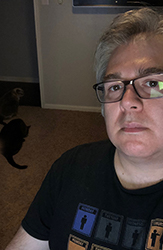
Michael Sicinski is an adjunct instructor who currently has a joint appointment in English and Fine Arts. He is a critic and scholar specializing in avant-garde and experimental cinema, but publishes more broadly on contemporary world cinema. Recent publications include a chapter comparing the films of Ulrich Köhler and Apichatpong Weerasethakul for Marco Abel and Jaimey Fisher’s collection The Berlin School In Its Global Contexts (Wayne State University, 2018), and an in-depth study of the films of Albert Serra for the journal Fireflies (2019). He also writes regularly for various film magazines, most notably the Canadian publication Cinema Scope. His is currently completing a doctoral dissertation at UC Berkeley that explores the liminal presence of experimental cinema within the current "attention economy."
Critical Studies
- ARTH 3394/6396: History of Video Art
This course traces the history of video art as a unique medium from the late 60s / early 70s until the present day, paying specific attention to the particular properties of analogue vs. digital technologies, as well as the aesthetic of “liveness” as opposed to the staging of fictitious profilmic events. Includes work by Joan Jonas, Dan Graham, Gary Hill, Bill Viola, Martha Rosler, Vito Acconci, Sadie Benning, Omer Fast, Ryan Trecartin, and others.
- ARTH 3396/6395: Feature Length Experimental Film
Academic film courses have tended to overlook the significant contributions of experimentalists who have chosen to work in the long form. In this course, we do not achieve broad coverage of the avant-garde. Instead, we conduct close analysis of twelve key films, considering how they employ the expanded use of time for uses other than the elaboration of story. Films include Vertov’s Man With the Movie Camera, Buñuel’s L’Age d’Or, Isou’s Treatise on Slobber and Eternity, Brakhage’s Dog Star Man, Mulvey/Wollen’s Riddles of the Sphinx, and Yvonne Rainer’s Journeys From Berlin / 1971.
- ENGL 2315: Literature and Film
This is a course that focuses on the relationships between film and literature, as distinct modes of narrative (and in some cases non-narrative or even anti-narrative) communication. We be address a few key concepts from both literary and film theory, in conjunction with close readings of specific film and literary texts. These concepts are as follows: narrative time (how does a plot “move” in both media?); authorial style (what makes one writer or filmmaker different from another?); and modes of portraiture (how does each medium construct a character?).